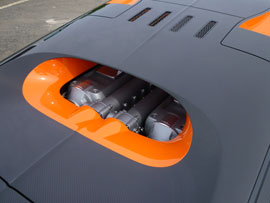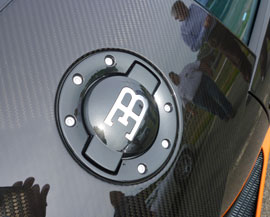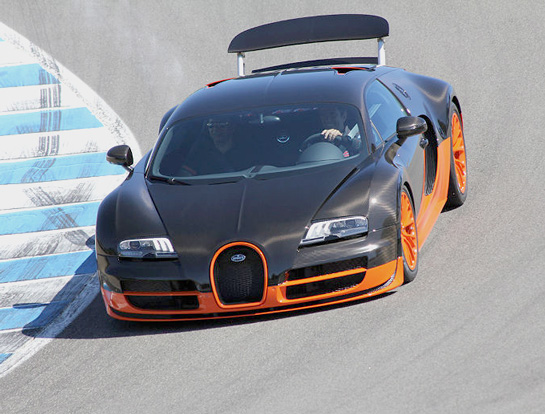By Werner Pfister
Is the new Bugatti fast enough to be at two places at the same time?
On August 15, at the Pebble Beach Concours, Bugatti debuted a new model of their very successful Veyron which had been developed in secret over the past year.
It was presented in unpainted black carbon fiber with orange painted accents and wheels and Bugatti announced that this was, in fact, the new world record breaking automobile.
Strangely, less than one week later on August 21st, the very same Bugatti along with their Grand Sport was spotted 3,000 miles away on the Montauk Highway in the Hamptons. Even in this wealthy town, which is the east coast summer playground of the Wall Street crowd, the sight of two Bugattis still turns a lot of heads. Leading us to wonder what is this car and just how rare is it. To understand this car, first we need to back track a bit on the history of record breaking.
Ultimate automobile speed records have been established for more than 100 years. A milestone worthy of comment was established in 1933, when Sir Malcolm Campbell broke the 270 mile per hour barrier in an automobile for the first time in history. The term automobile was used loosely as Campbell’s “Blue Bird” was a purpose built racer of immense proportions designed specifically to establish a new world automobile record. Yes, it had 4 wheels, but it weighed about 9,000 pounds and was 27 feet long and was powered by a supercharged Rolls-Royce V-12 aircraft motor displacing over 36 liters with a 2,300 horsepower output.
Eventually Campbell went on to reset the record at over 300 miles per hour on the famous Bonneville Salt Flats. Interestingly, when he was not breaking speed records, Campbell was a formidable competitor on the Grand Prix circuit. In fact he won the GP de Boulogne in 1927 and 1928 in a Bugatti 37A.
Seventy-seven years later, Bugatti has established a new world record of nearly 270 miles an hour in a production car, the Veyron Super Sport. Unlike Campbell’s car, the Bugatti is a bona fide road worthy automobile laden with many creature comforts, able to corner at almost 1.40 g’s and capable of stopping very quickly thanks to four huge carbon/ceramic brake rotors and an air brake.

The rear window is like a tunnel over the exposed engine and definitely more aerodynamic than the open engine compartment of the original design.
When Bugatti revealed the Veyron in 2006 to the world, their goal was to build the ultimate road car. It had a combination Carbon fiber and aluminum body fitted with a W-16 engine displacing 8 liters and featuring 4 turbos with an output of 1,001 horsepower. That combination was successful in establishing the world’s production car record at over 253 mph. The company then proceeded to forge ahead with production citing a limit of 300 units to be built.
Since that launch, a few upstart specialty car builders have been challenging Bugatti’s honor as the fastest production car. Truth is that these challengers make cars in very small numbers and therefore hardly qualify as “production” cars. Nevertheless, Bugatti decided to clear the air.
Veyron sales have been very successful during the past four years and there are now between 260 and 270 of the proposed 300 units already sold. As a parting shot, Bugatti decided to up the ante for the final 30 or so Veyrons by developing the Super Sport version.
This re-engineered super car has an all carbon fiber body resulting in a weight savings of approximately 50 kg. In addition, the aerodynamics have been very cleverly revised to make the car more slippery. The most notable change has been the elimination of the tall air snorkels on the roof with the air now flowing through roof mounted NACA duct. The revised, very clean design rear window looks great and actually has a vintage look.

The gas cap cover. This is on the right side of the body and an identical one on the left side of the body covers the dry sump oil filler/dipstick.
To push this more slippery shape through the wind, Bugatti also reworked the engine. They kept the displacement the same but increased the size of the turbos and supplemented the standard two fuel pumps with an additional pair. The engine now produces 1,200 horsepower.
The ultimate test of this engineering feat took place at VW’s Ehra-Lessien test track. Two months ago, Bugatti’s test driver, Pierre-Henri Raphanel drove the new Super Sport to a new world production car record of 268 miles an hour. That was his two way average, and on one leg of the record run Raphanel pushed the radar reading to a fraction shy of 270!
A few weeks ago, Bugatti unveiled the record breaking car at Pebble Beach in Carmel, California. It features a bare carbon fiber body with Orange trim and wheels. More than 20 Super Sports production slots are already committed with quite a few going to existing Veyron owners.

The special wheels built for the Super Sport are lighter than the normal Veyron or the Grand Sport wheels. They also flow more air to the brakes. In the Super Sport livery the wheels are typically painted the same as the lower part of the car.
Along with these record breaking Super Sport models, Bugatti will simultaneously continue to build the Grand Sport version which features a glass removable roof panel. Pierre-Henri says that the Grand Sport offers a different experience from the fixed roof Veyron and the roof mounted air intake “absolutely howls when driven at speed with the roof off!”
Ok, so what was this car doing in the Hamptons? Was it a clone or what? Bugatti says, ” No”, it was not a clone. There is only one record breaker and the car that made a bi-coastal appearance is the one and only. The real inside scoop is that apparently some east coast Bugatti owners were not able to attend Pebble Beach this year and as a courtesy, Bugatti brought the record breaker to them. Expensive marketing move? Of course, but at a price tag of more than $ 2.5 million Bugatti can offer this level of personalized service!



The problem with this car is that it cost about 2.6 million dollars…
Amazing car. I really enjoyed the BBC’s Top Gear episode when Captain Slow drove the “regular” Veyron on the VW test track. check it out:
http://www.youtube.com/watch?v=jk1t6S737Cs